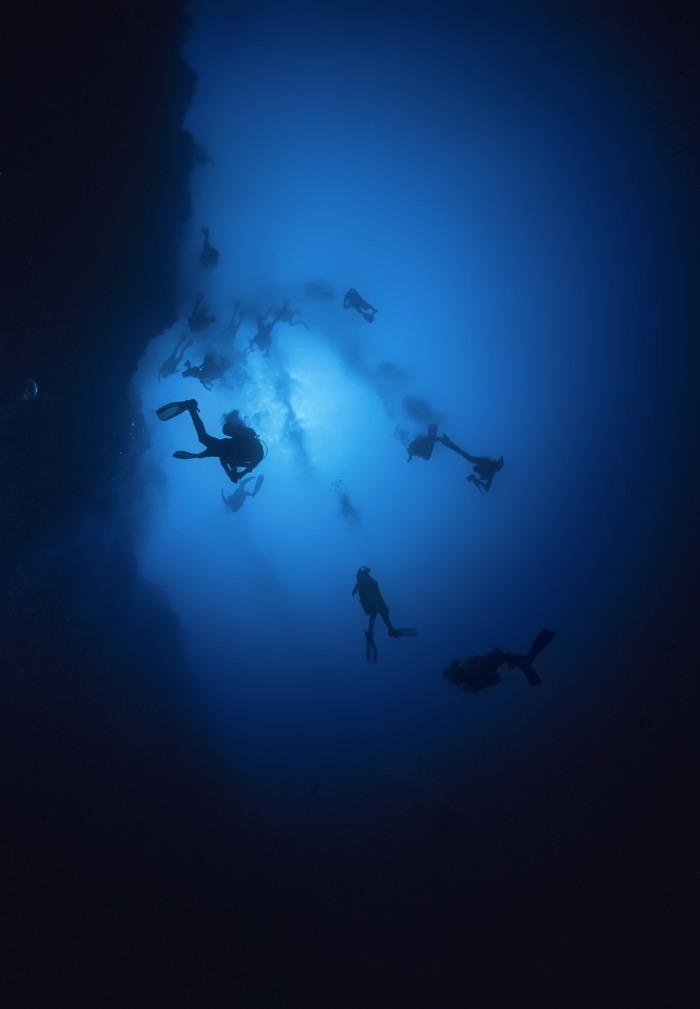Inside the Great Blue Hole of Belize

Dive and Snorkel Belize’s Blue Hole
An almost perfectly circular sinkhole measuring 300 meters across, the Great Blue Hole is one of the most popular and special sites for diving in the Belize Barrier Reef. Formed about 10,000 years ago at the end of the last Ice Age, the Blue Hole offers divers a uniquely gothic experience of starkly beautiful underwater caves featuring enormous stalactites and the occasional glimpse of the elusive hammerhead shark.
Why You Have to Visit the Blue Hole of Belize
Known to locals for centuries as a uniquely special diving location, the Blue Hole of Belize came to the world’s attention in 1971 after famed French marine biologist Jacques Cousteau declared it to be one of his top 10 diving spots in the world. Later, the Discovery Channel named the Belize Blue Hole as one of the top 10 most amazing places on Earth.
Every year, thousands of experienced divers from around the globe come to the Blue Hole of Belize to descend over 90 meters into the inky darkness.
Where in Belize Is the Blue Hole?
The Blue Hole of Belize is a UNESCO World Heritage Site located in the middle of the Belize Barrier Reef. The perimeter of the Belize Blue Hole is formed by Lighthouse Reef and is located approximately 43 miles (70 km) from mainland Belize.
When Is the Best Time to Visit the Blue Hole
As an underwater diving attraction, there is little variation by season or time of year so just about any time is a good time to explore the watery depths of the Belize Blue Hole. Be aware that storms or heavy rainfall can somewhat reduce visibility as well as make transportation to the Belize Blue Hole more difficult.
Exploring the Mysterious and Enigmatic Blue Hole of Belize
How to Get to the Blue Hole
There are no commercial routes that connect Lighthouse Reef (which surrounds the Belize Blue Hole) and the mainland or other islands. A number of private companies offer boat service to and from the area, as well as supplying the necessary diving gear and equipment.
Best way to Experience the Blue Hole
Due to the unique challenges of the depth of the Belize Blue Hole and exploring a series of submerged caves, diving in the area is restricted to experienced divers only. All divers must prove that they have completed at least 24 prior dives and can demonstrate proficiency in diving safety techniques.
What is it Like to Dive the Great Blue Hole of Belize? Glad You Asked!

In a word: It’s thrilling–even for experienced divers who have set about conquering the planet’s most challenging dives and come up proclaiming that they’ve “never seen anything like” the underwater world that captured their imaginations off the coast of Belize. Since the Great Blue Hole offers a diving experience that can’t be found elsewhere, we’ve borrowed the thoughts of divers who know a thing or two about life-changing experiences to explain what you can expect if you prioritize this dive next time you visit Belize.
It’s heart-thrilling deep.
You lower yourself into the circumference of the impressive circle that forms the ocean-top’s parameters and travel around 475 feet down into an expanse that was created by the geological movements of the earth’s crust. At its deepest, find yourself in what was once a series of caves that collapsed repeatedly to shape this conical aquatic phenomenon that differs from surrounding sea shelves because they are only around 390 feet deep. Your experience feels like you are plunging into a bottomless pit—but an awesome one.
It’s wildly mysterious.
Divers familiar with the Great Blue Hole often say that they became fascinated with the architecture that forms and reforms as the center of the earth cools and rocks shift into unique shapes, thereby delivering an other-worldly experience for even the most jaded of divers. Encounter Pleistocene stalactites, stalagmites and columns at a depth of around 110 feet. These projectiles dangle from massive shelves that are contoured in such a way one can burrow beneath them to find even more mysterious surfaces and shapes. There are passageways and coral-lined walls plus protrusions that can lead a diver to question his vision—but that’s part of the experience. The influence of nitrogen on the body at these depths can distort things just enough to add some magic to the moment.
It’s blue—but not just one shade of blue.
Turquoise blends into aquamarine that morphs into cobalt and navy, which is why your desire to experience marine life must be satisfied as near to the surface as possible. The darker it gets, the less marine life you’ll encounter. Trying to identify the range of blue hues you see can keep you busy as you descend into this natural Belize attraction gradually—darkening blues can give you an indication of the rate at which you are descending. As it gets darker and deeper, your ability to differentiate sea creatures that dare to plummet to such far depths makes it more likely you’ll encounter discarded turtle shells than a bounty of colorful fish who know enough to stay at the top of the hole.
It’s alive near the surface.
Adjust your vision to each stage of your dive and identify a wonderland of shapes, life forms and creatures that would do any science fiction illustrator proud. Spot shrimp clinging to anemones, oddly-shaped neon fish that glow against the blue water as they swim among butterfly fish, groupers and angelfish. Purple sea fans move to the ocean rhythmic sway, but with the right camera, you’ll be able to capture the moving sea life and even create your own special effects by allowing the water to mirror creatures and plants as they swim by. Experienced divers swear that they get the best pictures at a depth of around 6-feet because there’s so much light attracting marine life at that point, so follow their lead.
It requires company.
Diving with a buddy and sharing unique experiences is the essence of fun when exploring the Great Blue Hole. Not only will you stay safer and more confident as you descend into the aquamarine world of geologic outlines and indigenous life forms, but you can both point out photo opportunities to each other that could be illusive if you’re more focused on reaching the bottom than tracking what surrounds you. It’s particularly important to tackle this dive, if it’s your first, with an experienced person so you can relax completely and let the water and mood wash over you. Don’t be surprised if you find yourself gesturing wildly in the direction of your diving companion as you seek to interpret the beauty and wonder around you.
It’s deeply moving.
There’s a reason Jacques Cousteau targeted the Blue Hole back in 1972 and brought this diving site to the attention of the world. It’s just that unique. While there are lots of wild rumors surrounding the Cousteau visit when his ship Calypso’s dropped anchor and explored the depths, these stories are just so much local folklore, but since they don’t cost you a cent, do ask about them since they can be outrageous or highly entertaining at the very least. Your job is to make your own memories using stories passed along by other Great Blue Hole divers throughout Belize so you understand that while you encounter fewer life forms the deeper you dive, it’s the surroundings that are described by many as a “religious experience,” because you are visiting a world that has remained unchanged for thousands upon thousands of years.
It’s history.
Strangely, the Great Blue Hole doesn’t appear on admiralty charts, so it takes an experienced dive master to pinpoint the opening in the reef. For divers who thought they knew better, the Blue Hole became their watery resting place, despite the fact that it’s a fairly straightforward dive as long as you know what you’re doing. Ever since the Canadian Film Board produced a documentary in the mid-1960s, marine biologists, photographers, archaeologists and anyone seeking a one-of-a-kind experience has come to the realization that it’s not the marine life that makes the Blue Hole awesome; it’s the fact that the hole takes anyone seeking the mysteries of the cave into the barrier reef to experience a world that was once home to our ancestors around 11,000 years ago. As the sea continues to reclaim the Barrier Reef, more could be lost to history, including the hole itself. What’s it like to dive the Great Blue Hole?
Don’t you owe it to yourself to find out before it’s too late?
11 Interesting Facts about the Belize Blue Hole
1.) The Belize Blue hole is known to be one of the most stunning areas located in the Lighthouse Reef and is also considered a diving paradise.
2.) The Belize Blue Hole is not only the most unique area in the world, but is also the only blue hole that may be seen from space.
3.) This blue hole is almost a perfect circle and is over 1,000 feet or 305 meters wide and 480 feet or 146 meters deep.
4.) The Belize Blue Hole is in a cave that was formed above sea level. This may be proved by the fact that Stalagmites and Stalactites are unable to form underwater, and are only able to be formed due to constant dripping that is seen on stalagmites in many cave systems above ground.
5.) The area that holds the Belize Blue Hole is a World Heritage site and is one of many protected areas in Belize.
6.) The best spot for diving or snorkeling is within the first 40 feet of water above the Belize Blue Hole. Anything that is below that point is for experienced divers only.
7.) What people don’t really know is that the Belize Blue Hole only has 2 safe diving areas. You can go to the north side, which is the most popular side for large boats, since it is easier to access from there. The south side only allows small boats access due to specific wind directions. So, in order to dive, it must be done within the holes circumference.
8.) The Blue Hole doesn’t create that much circulation, so very little oxygen tends to reach the deepest part of the hole. This causes very few marine creatures the ability to survive there, even though bacteria seems to thrive.
9.) What makes the Belize Blue Hole so interesting is the fact that over 500 rare plants and animals that are located only in this area.
10.) Because Jacques Cousteau made his famous dive in 1960’s, a large number of scuba divers have started traveling to the Belize Blue Hole.
11.) The blue, deep waters of the Belize Blue Hole are the habitat to many hammerhead and black tip tigers. Although, all that you are likely to come upon is your diving partner during your expedition.
8 Amazing Photos of the Belize Blue Hole





















